Yarns to Love
Mighty Mill Tours: Harrisville Designs
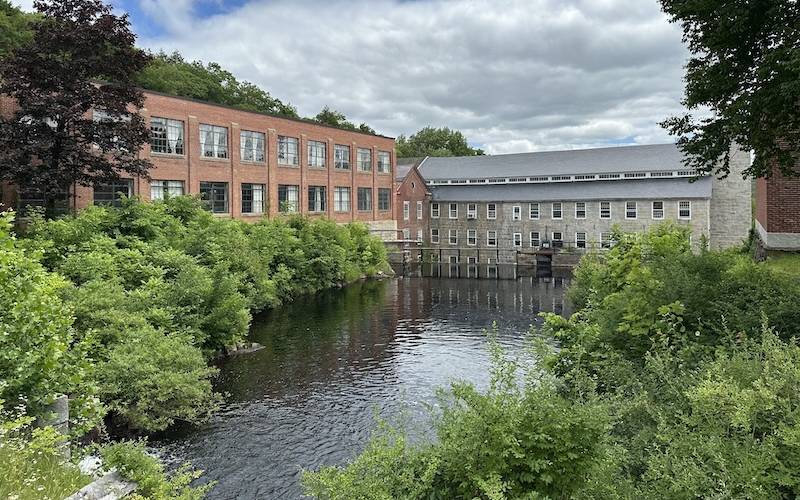

I’ve been extra curious about American mills and the yarns they make. Since I travel all around the country to teach, I decided to start visiting mills and further connecting how yarns are made to the knitted fabric in my hands.
My first mill is Harrisville Designs in Harrisville, New Hampshire.
I‘ve been a fan of their yarns for decades; they are fantastic for knitting, crocheting, and weaving. If you are in the market for a floor loom, they make great ones. Want something more immediate and lots of fun? Give their potholder looms a try. It’s still as much fun as it was when we were kids.
A Quick History
There has been a woolen mill in Harrisville since 1794. It is the only American textile village from the 19th century that survives in its original form and was designated a historic landmark in 1977.
Harrisville Designs has been spinning woolen yarns there for 50 years.
In 1971, John and Pat Colony wanted to produce high-quality 100% wool yarns and founded the mill. Since the earliest days, Harrisville Designs has offered weaving and other textile classes on site, as well as looms.
John and Pat’s son Nick spearheaded the implementation of water and solar power to Harrisville. Currently, the solar panels produce enough energy to power the mill.
I taught spinning at Harrisville this summer and was able to tour the mill with my class.
First stop is fiber. Harrisville uses a variety of fibers, both domestic and imported. It comes dyed and in natural colors packaged in giant bales.
The fiber is put through a picker to open the fibers and blend the colors. This machine has been picking fiber since the 1900s.
A carding machine further opens the fibers and pulls them into long thin strips that make them easier to spin.
The strips are similar to pin drafted roving or Plötulopi. At the end of the process, the strips are wound into big cakes.
The fiber cakes are moved to one of Harrisville’s two spinners. The fiber is further elongated or drafted and twisted to make a single ply of yarn.
You might recognize the big bobbins that the yarn is wound on. I know I’ve bought a few at antique stores. This is how they are originally used. Mine hold candles now.
After the plies are twisted together, the yarns are wound into hanks or onto cones, labeled, and sent out to eager knitters and weavers.
The Yarns
Harrisville spins several yarns that I’m sure you know, including Nightshades and Daylights. Their most recent yarn line is Shear, a breed-specific yarn from U.S. sheep.
Their two core yarns are Highland and Shetland. Highland has been one of my go-to basic yarns—but I’d never used Shetland.
Now I have a new favorite basic fingering weight yarn.
Shetland pays homage to yarns from the Shetland islands, like Jamieson and Smith. It is not from Shetland sheep—it’s a blend of Australian and New Zealand fibers, which make it both soft and hearty.
The “Shetland” part comes from its size (fingering) and how it’s spun (woolen and 2-ply).
It is a great yarn for knitting Fair Isle and it comes in 64 colors.
I did my usual getting-to-know-you swatch tour and learned a lot about this wonderful yarn.
Stockinette
The yarn is a smooth knit and acts like I would expect a 2-ply woolen yarn to do. The interesting part for me came when I blocked it. With stockinette I usually don’t pin my swatches, I just spread them out and give them a little friendly pat.
Can you see, especially in the center of the swatch, that it’s not smooth? That ripple speaks to good crimp in the fiber and a fabric that will be durable. Next time I will definitely use pins when I block.
Lace
I’m a fan of woolen-spun lace yarns. I like the softness of the stitches and the lightness of the fabric. Shetland makes an excellent lace fabric. I did pin this swatch and there are no ripples. The stitch pattern is beautifully open.
Cables
I was surprised by this yarn when I knit cables. I expected the cables to look softer and flatter than they do in this swatch. For such a light, 2-ply yarn, that is a good cable.
This a positive side to the same crimp that made my stockinette swatch ripple. Shetland has a tighter twist than a lot of woolen 2-ply yarns, giving it better stitch definition.
Colorwork
If you name a yarn Shetland, it better be good for colorwork—and it is!
Though I’m not a big colorwork knitter (texture knitting has all of my knitting heart), this yarn was easy to work with multiple colors.
The combination of woolen spinning and a 2-ply structure does a couple of great things for colorwork: the 2-ply structure softens the stitches, which allows the colors to blend together, and the woolen spin makes the yarn grabby, so floats and color changes stick to each other.
Wool is magic.
Plus, proof that friends of Modern Daily Knitting are everywhere!
Norah Gaughan’s studio is in Harrisville and we had a quick visit.

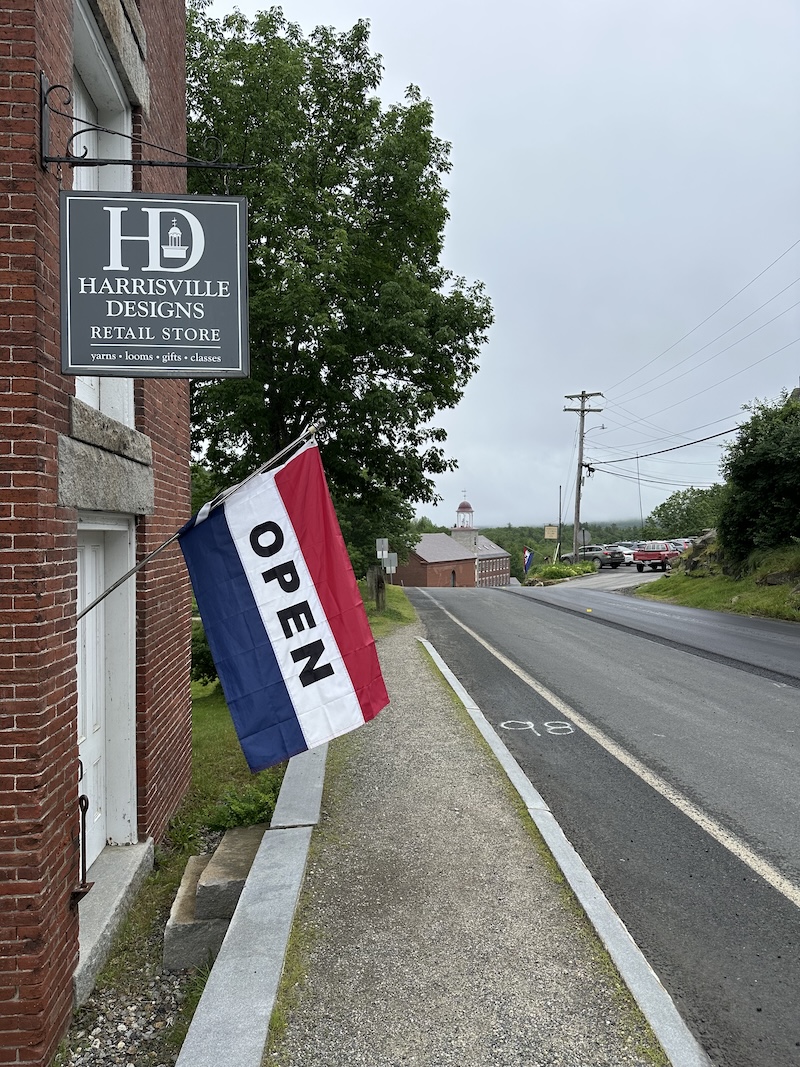
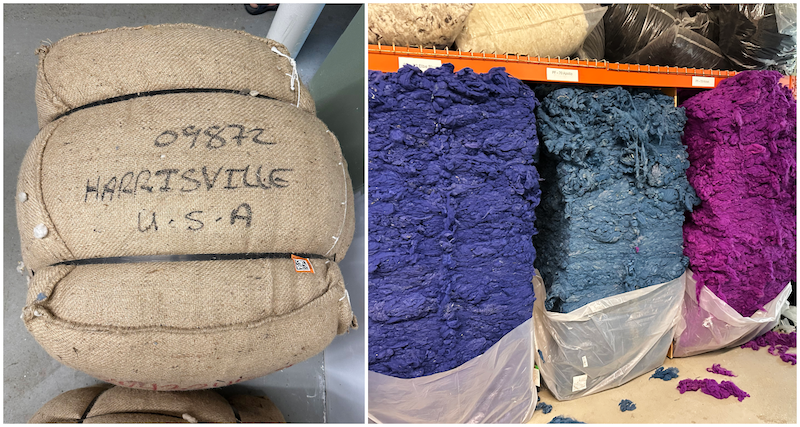
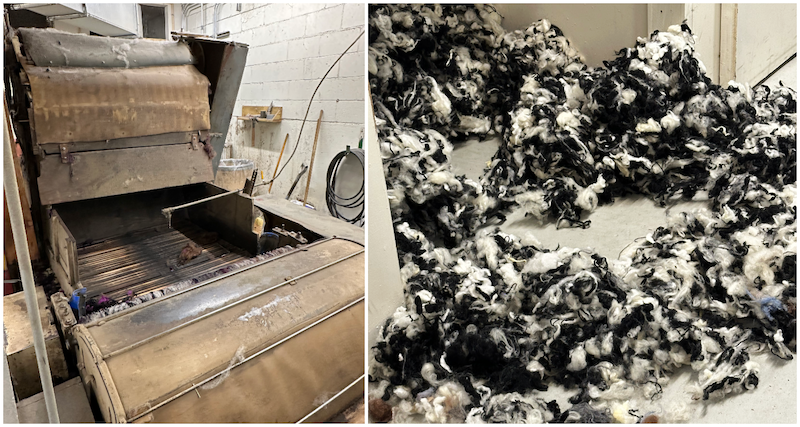
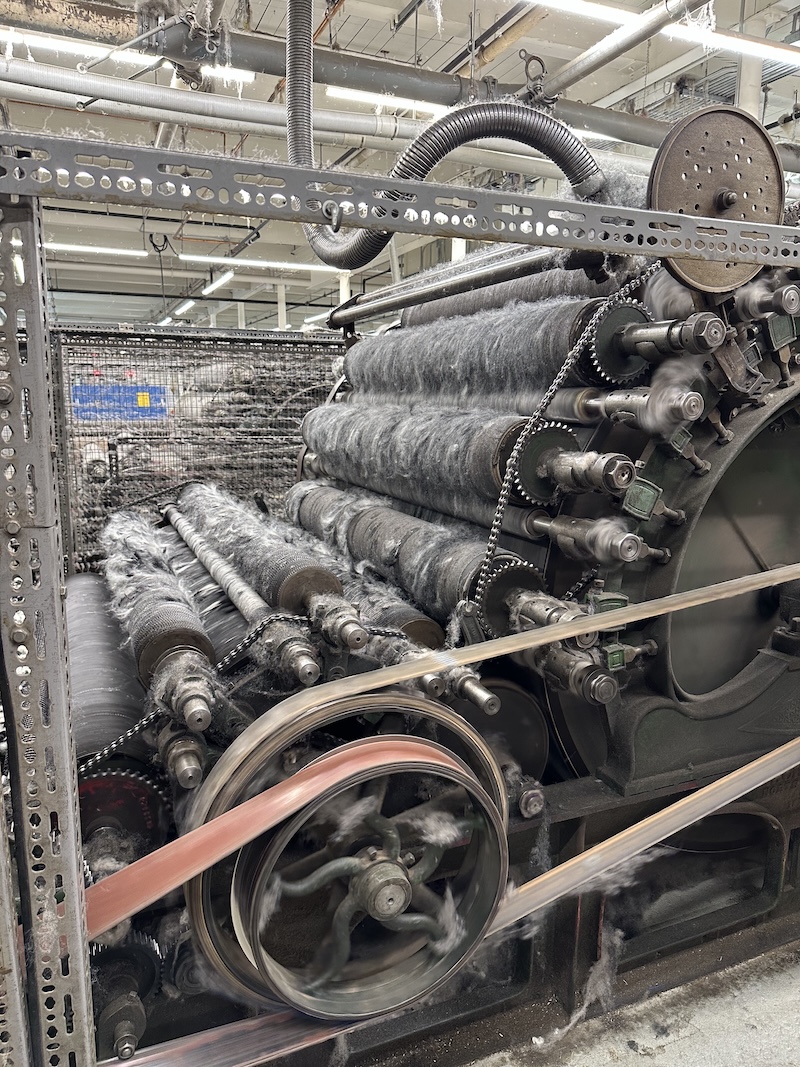
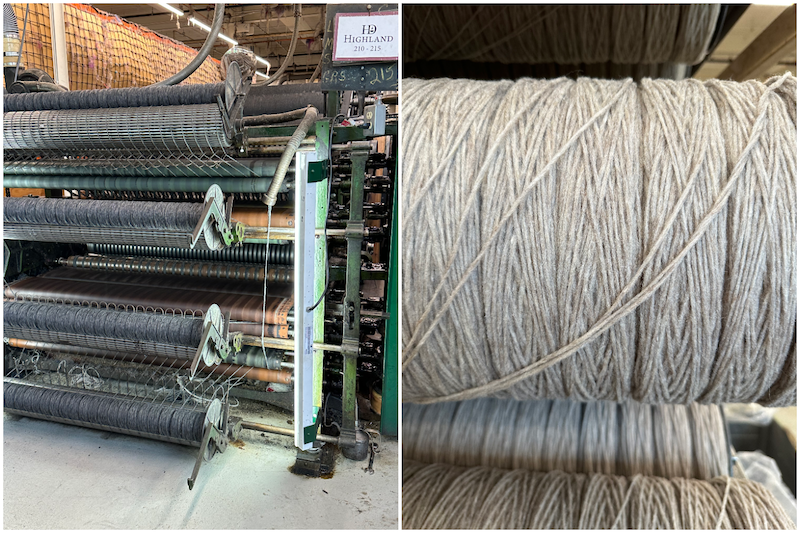
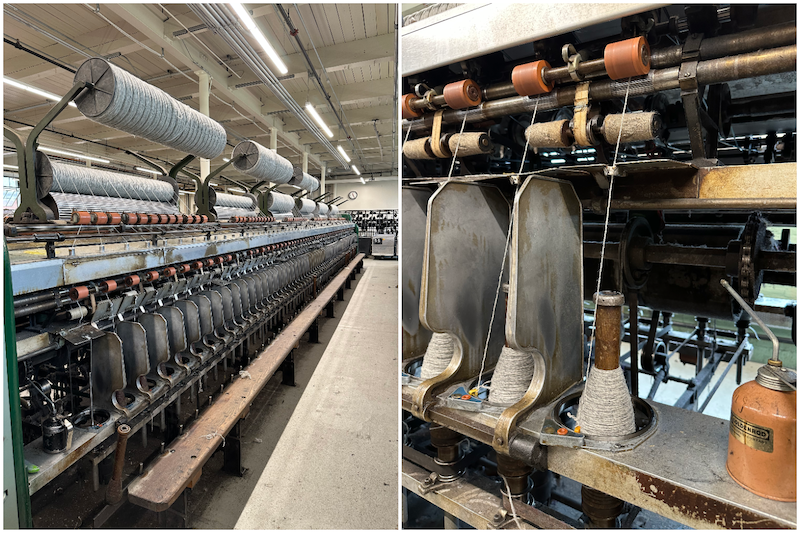
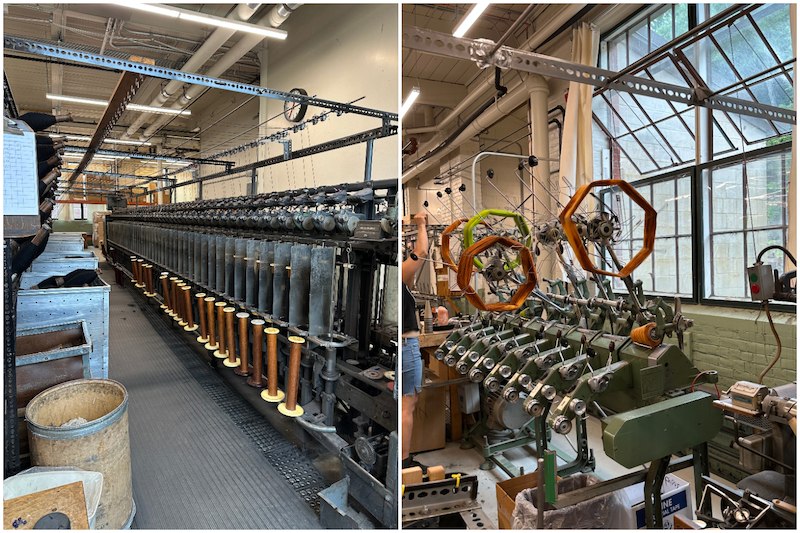
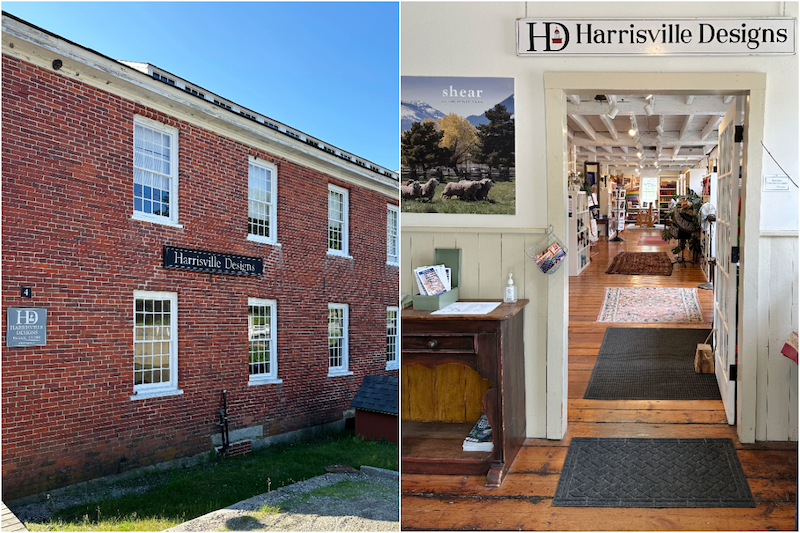
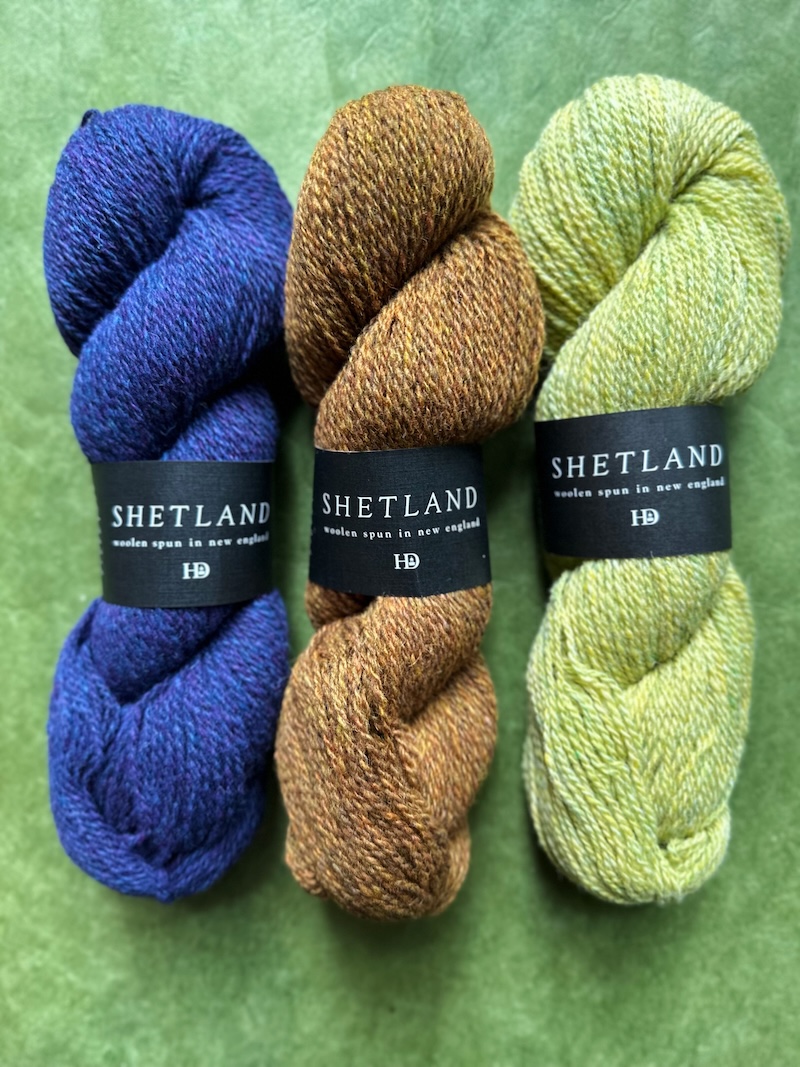
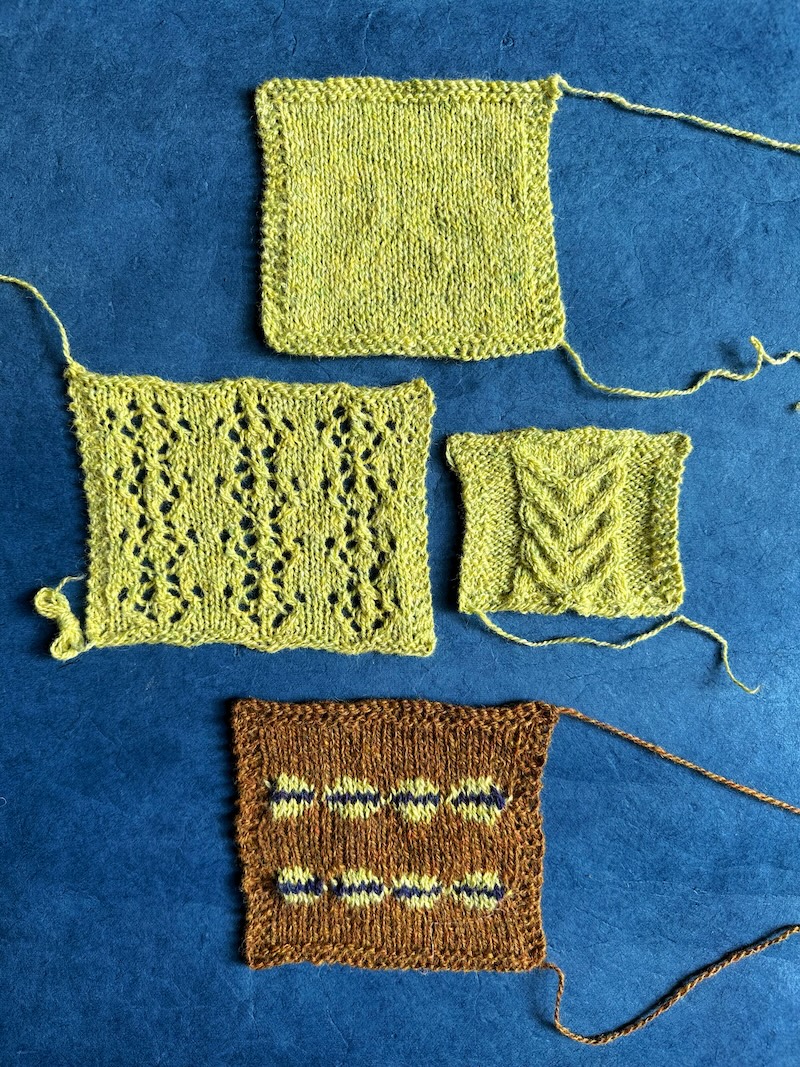
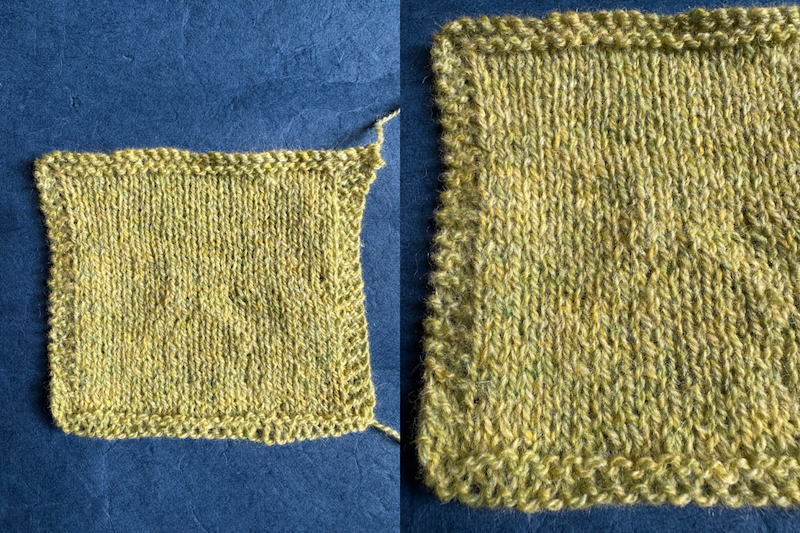
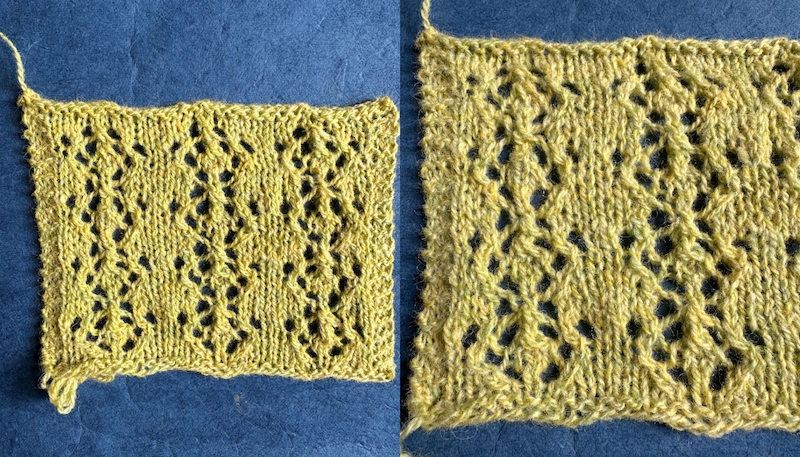
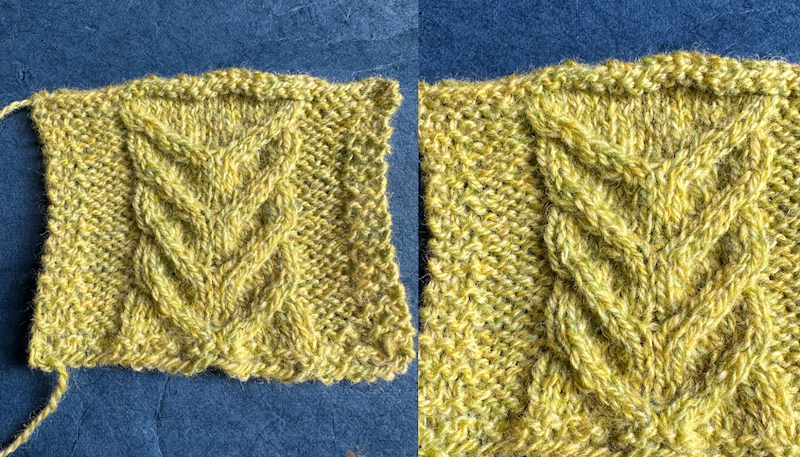
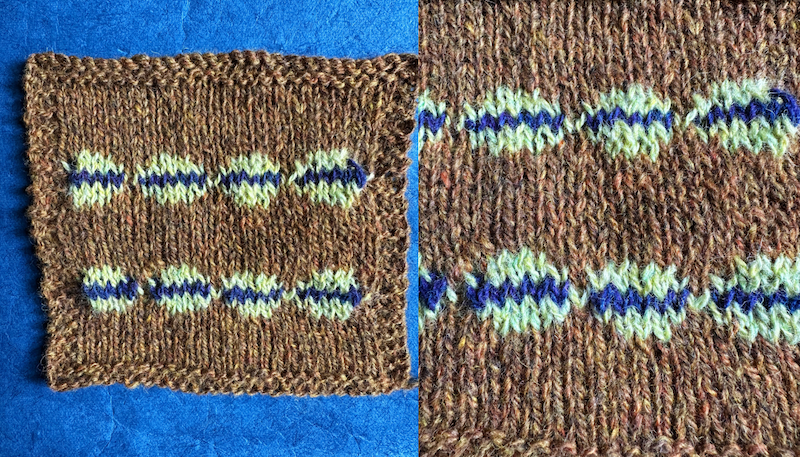
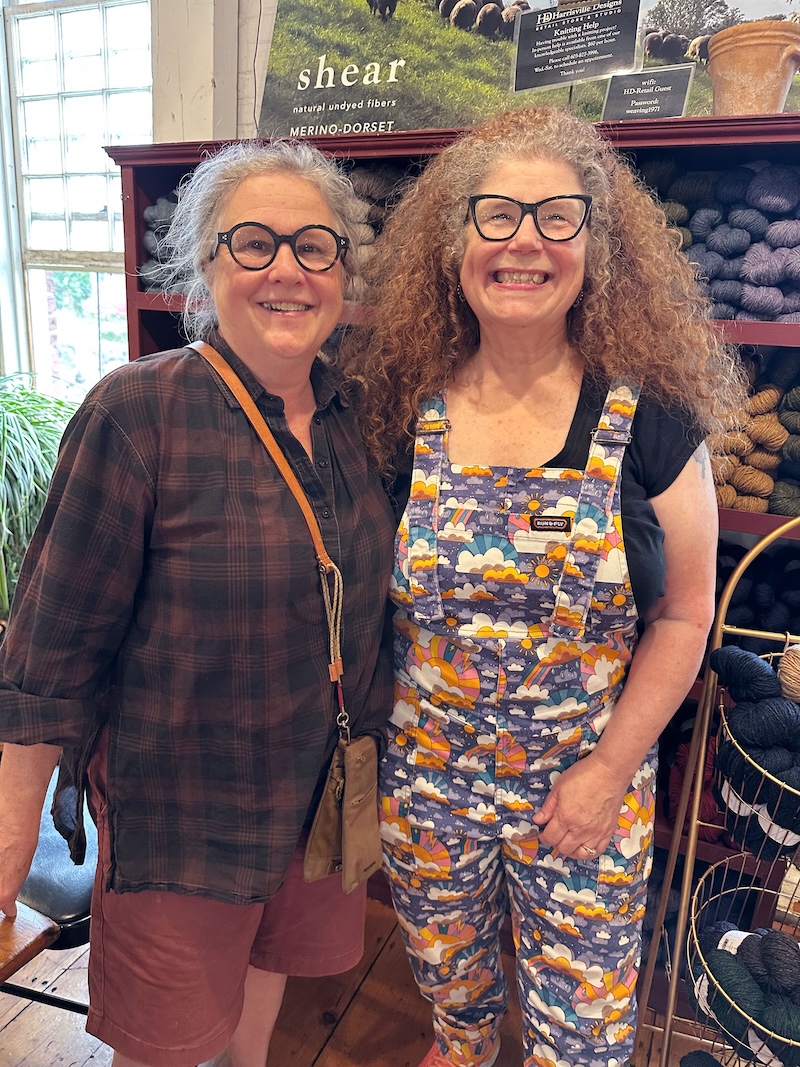

Harrisville is fabulous, and part of the reason I live in NH! I started coming for classes when I lived in NJ and had a daughter in college at Keene, NH. By the time we retired, I had friends up here and loved Harrisville (and the daughter married a NH guy and settled here, so here we are. I still go to Donna Kay’s class every fall and take any other classes I can fit into my life. Living this close to Harrisville is such a joy!
Such an excellent article! Looking at those huge bales makes me wonder how much yarn does a single average-sized sheep produce in one shearing?? A great picture with you and Norah. Really fun overalls, by the way:).
Thank you!
Fleece weights vary by breed.
I have 2lb Shetland fleeces & 9lb Corriedale fleeces in my stash.
As I am told, an average fleece = about 5 pounds of fiber. Obviously this is the average (mean, or adding all the total weights & dividing by the number of sheep sheared) of a very wide range given that a lamb’s 1st shearing will likely not be as big as a mature sheep’s, different breeds produce differing amounts & some sheep get sheared 2x per year, some 1x per year & some (poor sheep) may end up going several years between shearings.
I LOVE Harrisville–the mill, the shop, the yarns, the town, the deli, the whole package is picture-perfection. If you’re in New England, and willing to go off the beaten path some, it’s worth the stop. Absolutely, my favorite yarn destination.
So interesting and informative. I’m glad to learn about such a traditional mill in the US, we wool lovers need to honor them!
I recently was in at a knitting retreat in WE Wyoming and we hopped over to Brown Sheep Wool company in Nebraska for a field trip for a tour of their mill. It was fascinating. And they said it was unique for a mill to be in the middle of Nebraska because the humidity level is not optimal. Who knew that was a factor when spinning wool!
And of course we shopped in their onsite shop while we were there 🙂
Shout out to Brown Sheep! We here in Omaha think of it as located in the western end, not middle of the state. Ha, especially when we drove out and back to visit Grandma in Scottsbluff. Love their yarns, particularly for knitting felted mittens. Glad you were able to give them a visit.
So interesting! I wish I understood what is referred to in the last big paragraph as”spin”: “the woolen spin makes the yarn grabby…” How tightly or loosely it’s spun? Or something else?
There are two different styles of spinning yarn – how the twist gets into the fiber.
Worsted style smoothes and squeezes the air out of a yarn – making it smooth, dense, and giving it great stitch definition.
Woolen style allows air into the yarn as it’s spun – making it light, lofty, a little fuzzy and giving it softer stitch definition and the ability for the yarns to grab onto each other. I hope this helps!
Good question! The answer (I think!) I learned from Jillian’s book, Yarnitecture. Yarn is either woolen spun or worsted spun. Each has its own way of being drafted during the spinning process. Woolen spun drafting allows more air in the fibers so the yarn is fluffier and lighter weight, even though the dimensional size of the yarn is the same. Worsted spun has more grist and just feels denser because of the way it is drafted. I am not nearly a good enough spinner to consciously do one or the other, but Yarnitecture is a really super book to learn about yarns from, whether you are a spinner or a consumer of yarns (knitter, weaver, etc.). It has loads of info and beautiful photos that well illustrate the content and inspire one to just try stuff. I am not related in any way, just really have loved Jillian’s book for years, so pay attention when she writes these articles. Jillian, come to Seattle! The Puget Sound has smaller local mills that support local breeders and are worth exploring!
You are 100% correct!
Thank you for your kind words about my book.
I’m hoping to come out west next year!
Harrisville is a little gem of a village situated on the water, with tiny streets and brick buildings – it’s like stepping back in time. What a great place to visit, tour the mill and see Norah Gaughan, too! Thanks for sharing this treasure.
I enjoyed my virtual visit to Harrisville Designs. :):)
Thanks JDiane! I have “The Fleece and Fiber Sourcebook” (highly recommend) but that information did not jump out at me. What a lot of fiber (it seems to me) from a smallish animal (minus her fleece!) and all the potential she gives just by munching on vegetation all day! Three cheers to the shearers who make all this potential possible.
Here, here!
I’ve used Harrisville’s Daylights yarn to make a cardigan for my granddaughter when she was 2. Beautifully pretty and fine quality yarn. Great article Jillian, I always look forward to your contributions to the MDK daily read.
Thank you!
What I love about Harrisville yarn is the colors. Instead using dyed fleece to make one flat color, each yarn color is made with a specific “recipe” of colored fleece that is carded and spun together. If you look closely at the finished product you can see all the colored strands. Gorgeous! Also it washes up so beautifully. I am also biased, I used to work there in the 90s. What a treat.
I bought the big potholder loom and loops from Harrisville over lockdown, and it was part of my zoom activities when I wasn’t sewing masks.
Great stuff.
Thanks for the ‘tour.’
I have always looked for local yarn shos when traveling and will now add fiber mills. Such a special treasure we have!
We discovered Ohana Fiber Mill on the Big Island of Hawaii…definitely add that to your list!
Thank you for your suggestion!
Loved this article! Yarn made in USA – good to know. Give us more …
Thank you for the tour, Jillian! I’ve ordered some things from Harrisville through the years (love the potholder looms!) but haven’t had a chance to visit. I like the idea of a mill tour travel itinerary.
Yes ! My kind of tourism.
I love Harrisville yarns! My last cardigan was all cables in Highland and my current sweater project is colorwork in Shetland. They’re the perfect, wearable, sheepy yarns.
Thank you for sharing the tour!
Pardon me while I wipe the drool from my keyboard, but the colors on the Shetland? Be still, my heart!
I’ve been sitting on a SQ of Highland that is in the queue for next year. Shetland is definitely in my future.
Harrisville – what a favorite! I’ve bought from them at Rhinebeck and also ordered directly online. I had reason to call them during the pandemic lockdown. Like so many people I had plenty of downtime and apparently the woman who answered wasn’t busy either because we spent a good twenty minutes on the phone chatting about colors, yarn, and knitting.
My Harrisville projects completed and in constant use:
lace yoke cardigan in Shetland
multicolor mosaic shawl in Shetland
Cabled gloves in Flywheel
Cabled fingerless mitts in Flywheel (3 pairs)
I still have in stash a SQ of Shetland + assorted leftovers that will become a sweater this fall.
The best $10 I spent was on a color card of Harrisville “Classic Line” which includes the 64 colors available in Highland & Shetland. It is genius for a yarn seller to offer color cards. All things being equal I automatically buy Harrisville because I can see the actual colors.
Thank you, MDK and JM, for writing about an American mill.
Wow, Norah Gaughan right in “my own backyard”! Worcester, Ma here, ready for a fieldtrip to Harrisville, NH. Who’s with?! What a sweet reminder that beautiful fiber is still “state side”. A little travel exploration, no tarriffs. Yay! Xoxo, g.
Greetings from another born and raised Worcester woman! I left when I was 23, but it will always be home.
Wow, Norah Gaughan right in “my own backyard”! Worcester, Ma here, ready for a fieldtrip to Harrisville, NH. Who’s with?! What a sweet reminder that beautiful fiber is still “state side”. A little travel exploration, no tarriffs. Yay! Xoxo, g.
Harrisville is magical. I knit a favorite poncho out of Nightshades that I actually bought at the Edinburgh Yarn Festival the last year it was on (2019?).
Another mill that might interest you is the Junction Fiber Mill in White River Junction, VT. It’s relatively new but has lovely yarns and they do usually go to Rhinebeck. It’s much smaller than Harrisville but is cherished because there are so many fewer mills these days. And it looks like we’ll be needing more of them, and more sheep farmers here in the states since no one will ship to us anymore. 🙁
But I’m not going to let you know who stop me from knitting.
I just received my yarn to knit Andrea Mowry’s Night and Day Cowl. So far the yarn is easy to knit with! I love woolen spun yarn.
I have been to the Harrisville Mill. This is a delightfull place, driving into the mill and seeing all the large buildings.
Being raised in the northwest the historic building are jaw dropping.
I loved the store and workshops being held upstairs, listening to class participants.
So many yarns at my feet and almost tumbling out of the shelves. I came away with natural worsted spun grey for warp and woolen yarn for weft. It made a beautiful twill throw with an accent yarn I had space dyed in a workshop with Deb Menz.
I’m knitting Flynn, an all-over cable sweater, in Harrisville Nightshades and really enjoying the yarn. It’s my first time using Nightshades–and the cables look great in this yarn.
I love it.
Great article! I’m a toy maker/designer and use Harrisville Shetland almost exclusively for my products. Love their yarns and working with their company.
I always look forward to your writing. I learn so much. Harrisville is now on my bucket list of yarn places of interest. Thank you!
I definitely need to visit that mill. I recently spent a day in Harmony, Maine at the Bartlett mill. What an extraordinary experience.
What I love about Harrisville yarn is the colors. Instead using dyed fleece to make one flat color, each yarn color is made with a specific “recipe” of colored fleece that is carded and spun together. If you look closely at the finished product you can see all the colored strands. Gorgeous! Also it washes up so beautifully. I am also biased, I used to work there in the 90s. What a treat.
En route to a teaching (art quilting) trip, I was able to visit the mill store.. OH MY! Alas, summer road work season foiled my plans and I got only about a 17 minutes zip through before the store closed. It was SO GORGEOUS–the space, the yarn… can’t wait to have an excuse to head from near-the-coast in Maine back to Harrisville.
Jillian, I Love love LOVE how much I learn from you about how yarns will behave in my knitting. Although my hands are crabby enough from age and arthritis that I will likely not take up spinning, I’d love to learn more and more from you. Thank you!